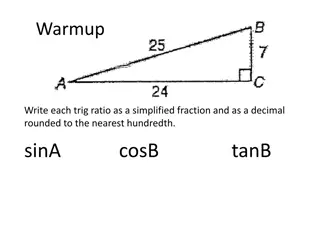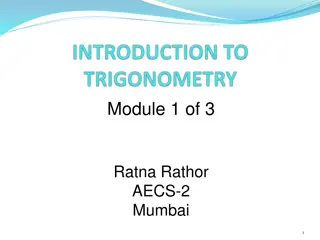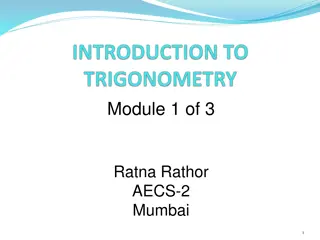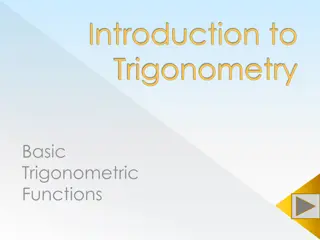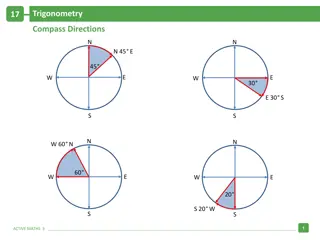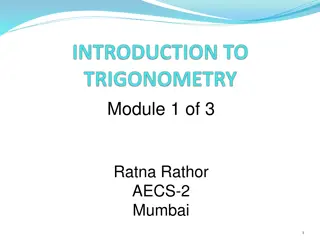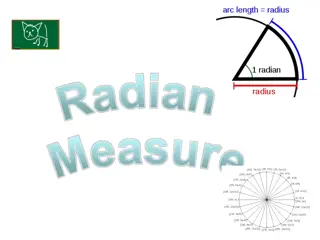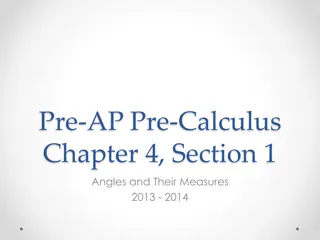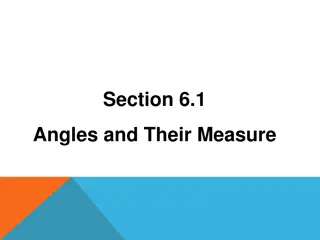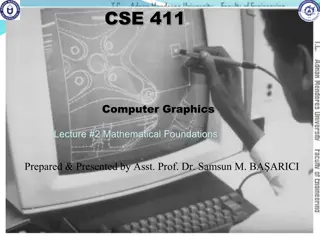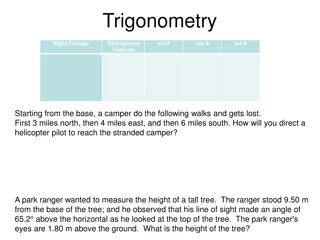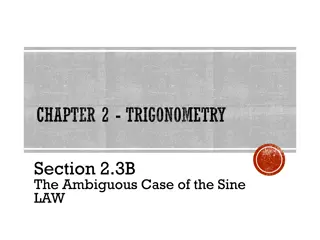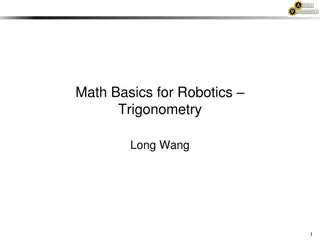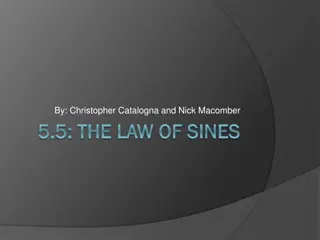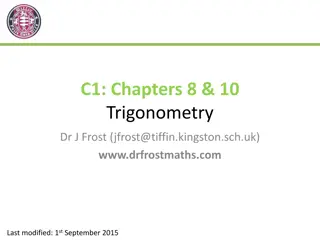Solving for the Unknown: Basic Operations & Trigonometry
Algebra is the key to solving unknown values through mathematical expressions. By understanding the order of operations and using basic algebraic principles, you can uncover the values of variables in equations. Learn about PEMDAS, inverting equations, and applying operations to find solutions. Explore examples of basic operations and trigonometry functions to enhance your mathematical reasoning skills.
Download Presentation

Please find below an Image/Link to download the presentation.
The content on the website is provided AS IS for your information and personal use only. It may not be sold, licensed, or shared on other websites without obtaining consent from the author.If you encounter any issues during the download, it is possible that the publisher has removed the file from their server.
You are allowed to download the files provided on this website for personal or commercial use, subject to the condition that they are used lawfully. All files are the property of their respective owners.
The content on the website is provided AS IS for your information and personal use only. It may not be sold, licensed, or shared on other websites without obtaining consent from the author.
E N D
Presentation Transcript
Solving for the Unknown: Basic Operations & Trigonometry ID1050 Quantitative & Qualitative Reasoning
What is Algebra? An expression is a combination of numbers and operations that leads to a numerical result Example: If x=2, what is 3x2+2? For these problems, we plug and chug . We substitute the number for x, and we evaluatethe expression. In algebra, we have an equation, and we don t know the value of x (or whatever variable name we are using.) Example: 3x2+2=14 For these problems, we need to solve for the unknown x, so we used rules of algebra to invert all of the operations acting on x, leaving x by itself on one side of the equation At every inversion step, we also apply the same inversion to the number on the other side, eventually leaving the result of what x is. For our example, x=2.
Order of Operations and Inversions When evaluating an expression, we adhere to a specified order when we apply operations like addition, squaring, etc. This is called the order of operations. The order is listed to the right. Expressions in parenthesesshould be evaluated first. Exponentoperations should be evaluated next, followed by multiplication, etc. One mnemonic for PEMDASis please excuse my dear Aunt Sally . When inverting an equation, we must go backwards through PEMDAS. We invert the operations on the unknown x in reverse order of how the operations would have been applied if we had known x from the start. (evaluating) PEMDAS (inverting) Parentheses Exponents Multiplication Division Addition Subtraction
Basic Operations We have seen examples of inverting single operations like addition or division. We don t need PEMDAS for this. When we have two or more operations, we need PEMDAS to determine the correct order. If the two operations are the same (addition and addition), the order doesn t matter. 2-step inversion example: 4x-1=3 We ask what operations are acting on x? They are multiplication by 4 and subtraction of 1. PEMDAS says we invert Subtraction first (by addition of 1), then invert Multiplication next (by division by 4.) Remember to apply the inversion operation to both sides. Invert subtraction: 4x-1+1 = 3+1or 4x=4 Invert multiplication: 4x/4 = 4/4 or x=1 (evaluating) PEMDAS (inverting) Parentheses Exponents Multiplication Division Addition Subtraction Function/Inverse Pairs Multiply and divide Addition and subtract
Basic Operations 3-step inversion example: 2x/3+4=6 What operations act on x? Multiplication by 2 Division by 3 Addition of 4 PEMDAS says we should invert addition first, division next, and multiplication last. Subtract 4 from both sides: 2x/3+4-4 = 6-4 or 2x/3 = 2 Multiply both sides by 3: 2x/3*3 = 2*3 or 2x=6 Divide both sides by 2: 2x/2 = 6/2 orx=3 Any number of basic operations can be inverted in this way. (evaluating) PEMDAS (inverting) Parentheses Exponents Multiplication Division Addition Subtraction Function/Inverse Pairs Multiply and divide Addition and subtract
Trigonometry Functions and Basic Operations Trigonometry functions don t appear explicitly in PEMDAS. If they did, they would be between Parentheses and Exponents. 2-step inversion example: tan(x)+1=0 Operations on x: tangent and addition of 1 Subtract 1 from both sides: tan(x)+1-1=0-1 or tan(x)= -1 Inverse tangent of both sides: tan-1[tan(x)]= tan-1[-1] or x=-45o 3-step inversion example: 2*sin(x)-1=0 Operations on x: multiplication, sine, and subtraction Add 1 to both sides: 2*sin(x)-1+1 = 0+1 or 2*sin(x)=1 Divide both sides by 2: 2*sin(x)/2 = 1/2 or sin(x)=0.5 Inverse sine of both sides: sin-1[sin(x)] = sin-1 [0.5] or x=30o (evaluating) PEMDAS (inverting) Parentheses Exponents Multiplication Division Addition Subtraction Function/Inverse Pairs Sin() and Sin-1() Cos() and Cos-1 () Tan() and Tan-1 ()
Trigonometric Inverses and Basic Operations Trigonometric inverses don t appear explicitly in PEMDAS. If they did, they would be between Parentheses and Exponents. 2-step inversion example: tan-1(x)+60o=30o Operations on x: inverse tangent and addition Subtract 600 from both sides: tan-1(x)+600-600=30o-600or tan-1(x)=-30o Apply tangent to both sides: tan[tan-1(x)]= tan[-30o] or x=-0.577 3-step inversion example: 2*cos-1(x)/3=40o Operations on x: division, inverse cosine, and multiplication Multiply both sides by 3: 2*cos-1(x)/3*3 = 400*3 or 2*cos-1(x)=1200 Divide both sides by 2: 2*cos-1(x)/2 = 1200/2 or cos-1(x)=600 Apply cosine to both sides: cos[cos-1(x)] = cos[600] or x=0.5 (evaluating) PEMDAS (inverting) Parentheses Exponents Multiplication Division Addition Subtraction Function/Inverse Pairs Sin() and Sin-1() Cos() and Cos-1 () Tan() and Tan-1 ()
Conclusion The order of operations (PEMDAS) provides a plan for applying operations when evaluating expressions or solving equations. When solving for the unknown x, we invert operations in reverse order through PEMDAS. Trigonometry function and inverses would be done between the P and the E. If two operations are the same (e.g. addition, as in 3+x+6), then they can be applied or inverted left-to-right.



